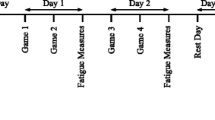Abstract
The present study aimed at examining the physiological characteristics and metabolic demands of badminton single match play. Twelve internationally ranked badminton players (eight women and four men) performed an incremental treadmill test [VO2peak = 50.3 ± 4.1 ml min−1 kg−1 (women) and 61.8 ± 5.9 ml min−1 kg−1 (men), respectively]. On a separate day, they played a simulated badminton match of two 15 min with simultaneous gas exchange (breath-by-breath) and heart rate measurements. Additionally, blood lactate concentrations were determined before, after 15 min and at the end of the match. Furthermore, the duration of rallies and rests in between, the score as well as the number of shots per rally were recorded. A total of 630 rallies was analysed. Mean rally and rest duration were 5.5 ± 4.4 s and 11.4 ± 6.0 s, respectively, with an average 5.1 ± 3.9 shots played per rally. Mean oxygen uptake (VO2), heart rate (HR), and blood lactate concentrations during badminton matches were 39.6 ± 5.7 ml min−1 kg−1 (73.3% VO2peak), 169 ± 9 min−1 (89.0% HRpeak) and 1.9 ± 0.7 mmol l−1, respectively. For a single subject 95% confidence intervals for VO2 and HR during match play were on average 45.7–100.9% VO2peak and 78.3–99.8% HRpeak. High average intensity of badminton match play and considerable variability of several physiological variables demonstrate the importance of anaerobic alactacid and aerobic energy production in competitive badminton. A well-developed aerobic endurance capacity seems necessary for fast recovery between rallies or intensive training workouts.



Similar content being viewed by others
Notes
The original publication by Jeukendrup and Wallis (2005) contains an error. The equation is given as EE = 0.550*VCO2 – 4.471*VO2. Re-tracking of the mathematical deduction resulted in the equation used in the present manuscript. The equation is proposed for calculating gross energy expenditure during moderate to high intensity exercise (50–75% VO2max).
References
Buchfuhrer MJ, Hansen JE, Robinson TE, Sue DY, Wasserman K, Whipp BJ (1983) Optimizing the exercise protocol for cardiopulmonary assessment. J Appl Physiol 55:1558–1564
Cabello Manrique D, Gonzalez-Badillo JJ (2003) Analysis of the characteristics of competitive badminton. Br J Sports Med 37:62–66
Christmass MA, Dawson B, Passeretto P, Arthur PG (1999) A comparison of skeletal muscle oxygenation and fuel use in sustained continuous and intermittent exercise. Eur J Appl Physiol Occup Physiol 80:423–435
Costill D (1970) Metabolic responses during distance running. J Appl Physiol 28:251–255
Docherty D (1982) A comparison of heart rate responses in racquet games. Br J Sports Med 16:96–100
Faccini P, Dal Monte A (1996) Physiologic demands of badminton match play. Am J Sports Med 24:S64–S66
Ferrauti A, Bergeron MF, Pluim BM, Weber K (2001) Physiological responses in tennis and running with similar oxygen uptake. Eur J Appl Physiol 85:27–33
Ferrauti A, Giesen HT, Merheim G, Weber K (2006) Indirect calorimetry in a soccer game. Dtsch Z Sportmed 57:142–146
Ghosh AK, Goswami A, Ahuja A (1993) Evaluation of a sports specific training programme in badminton players. Indian J Med Res 98:232–236
Glaister M (2005) Multiple sprint work: physiological responses, mechanisms of fatigue and the influence of aerobic fitness. Sports Med 35:757–777
Hagerman FC, Lawrence RA, Mansfield MC (1988) A comparison of energy expenditure during rowing and cycling ergometry. Med Sci Sports Exerc 20:479–488
Jeukendrup AE, Wallis GA (2005) Measurement of substrate oxidation during exercise by means of gas exchange measurements. Int J Sports Med 26(Suppl 1):S28–S37
Lewis DA, Kamon E, Hodgson JL (1986) Physiological differences between genders. Implications for sports conditioning. Sports Med 3:357–369
Majumdar P, Khanna GL, Malik V, Sachdeva S, Arif M, Mandal M (1997) Physiological analysis to quantify training load in badminton. Br J Sports Med 31:342–345
Meyer T, Davison RC, Kindermann W (2005) Ambulatory gas exchange measurements—current status and future options. Int J Sports Med 26(Suppl 1):S19–S27
Miao SK, Wang SW (1988) The measurement of aerobic, anaerobic capacity and extremital strength of Chinese top badminton players. Abstr New Horiz Hum Mov 3:252
Reilly T, Ball D (1984) The net physiological cost of dribbling a soccer ball. Res Q Exerc Sport 55:267–271
Roecker K, Prettin S, Sorichter S (2005) Gas exchange measurements with high temporal resolution: the breath-by-breath approach. Int J Sports Med 26(Suppl 1):S11–S18
Roepstorff C, Steffensen CH, Madsen M, Stallknecht B, Kanstrup IL, Richter EA, Kiens B (2002) Gender differences in substrate utilization during submaximal exercise in endurance-trained subjects. Am J Physiol Endocrinol Metab 282:E435–E447
Sheel AW, Richards JC, Foster GE, Guenette JA (2004) Sex differences in respiratory exercise physiology. Sports Med 34:567–579
Smekal G, von Duvillard SP, Rihacek C, Pokan R, Hofmann P, Baron R, Tschan H, Bachl N (2001) A physiological profile of tennis match play. Med Sci Sports Exerc 33:999–1005
Stolen T, Chamari K, Castagna C, Wisloff U (2005) Physiology of soccer: an update. Sports Med 35:501–536
Tomlin DL, Wenger HA (2001) The relationship between aerobic fitness and recovery from high intensity intermittent exercise. Sports Med 31:1–11
Weiler B, Urhausen A, Coen B, Weiler S, Huber G, Kindermann W (1997) Sportmedizinische Leistungsdiagnostik (allgemeine Laufausdauer und Sprintvermögen) und Streßhormon-Messungen im Wettkampf bei Badmintonspielern der nationalen und internationalen Spitzenklasse. Sportorthopädie Sporttraumatologie 13:5–12
Acknowledgments
The authors want to express their gratitude to Cortex Biophysik, Leipzig, Germany, for providing the metabolic systems (MetaMax 3b) used in this study.
Author information
Authors and Affiliations
Corresponding author
Rights and permissions
About this article
Cite this article
Faude, O., Meyer, T., Rosenberger, F. et al. Physiological characteristics of badminton match play. Eur J Appl Physiol 100, 479–485 (2007). https://doi.org/10.1007/s00421-007-0441-8
Accepted:
Published:
Issue Date:
DOI: https://doi.org/10.1007/s00421-007-0441-8




